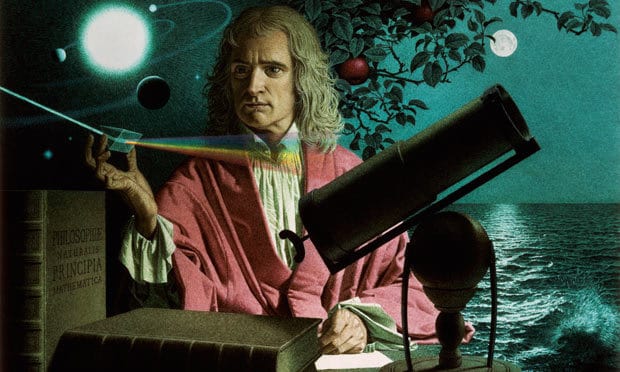Sir Isaac Newton is one of the most influential scientists of any age. He laid the foundations of classical mathematics, revealed the laws of gravity and built the first reflecting telescope.
But the last years of his life were spent on a more prosaic pursuit when he accepted a position as warden and later master of the Royal Mint. Here, Newton applied his scientific knowledge and perseverance to the reform of the British currency. He remained in the post until the end of his life.
But why did such a scientific luminary take such a job? And how could a scientist improve the world of British finance?
A Life of Science
Depending on whether you use the Julian or the Gregorian calendar, Isaac Newton was born into a poor farming family on December 25, 1642- or January 4, 1643. Newton’s father had died three months earlier and his mother quickly remarried, leaving Isaac with her parents. She did not return until 7 years later, a widow again and with 2 daughters and a further son in tow.
Newton was a clever boy and educated at Grantham Grammar School in Lincolnshire. But his brilliant future career may have been somewhat less illustrious if it were not for his headmaster Henry Stokes. Newton’s mother pulled him out of school before he had finished his studies as she wished him to provide for her and his siblings through farming. Stokes ensured his protégé finished his schooling and Newton escaped to a place at Cambridge University to study ethics and the natural philosophy of Aristotle.

But Newton became distracted from philosophy by science. He began to set up a private laboratory in the grounds of Trinity College as he became bored with his curriculum studies. A notebook from this period begins with notes on Aristotle but slowly changes to fill up with scientific and mathematical theories.
So, when Newton finally graduated from his formal studies, it was without distinction. But once again, he was fortunate in attracting the attention of one of his tutors, this time Isaac Barrow, the professor of Mathematics. So Newton stayed at Cambridge, dedicating his time to mathematics, physics, and astronomy.
In 1664, he was forced to return to Lincolnshire when the Great Plague shut Cambridge University down. This was to be a fortunate thing, for it was during his time at home, Newton began work on the subject he is best known for: The theory of Gravity.

Gravity and Other Discoveries
The story of Newton’s discovery of gravity is largely anecdotal, based on a tale credited to the French author Voltaire, who was supplied with the information by Newton’s niece. But the English antiquarian William Stukeley confirmed the story, claiming Newton himself had told him it to him first hand in 1726.
Either way, in 1684, Newton explained to the public what stopped the universe from flying apart when he published his first treatise on gravity “De Motu Corporum” before expanding on the principle in 1687 in “Philosophiae Naturalis Principia Mathematica”.
But this was not all. In 1665-66, Newton developed the binomial theorem and differential and integral calculus. By 1667, he was a Fellow of Cambridge and two years later a Professor of Mathematics. By the time he was 30 in 1672, he was a Fellow of the Royal Society.
But by 1678, Newton was dabbling with alchemy, using furnaces and chemicals. His experiments centered on metal and totaled 108 in all. Some were strange, to say the least, including the analysis of taste of metals such as lead, gold, mercury, and arsenic!
The Nervous Breakdowns
These experiments may have had their part to play in the two documented nervous breakdowns Newton suffered.
Newton was known to be a deeply private person. His private papers give away very little about his thoughts and feelings. But what they do reveal is a tendency towards depression and a black temper. In a list of his ‘sins’ Newton recorded in his late youth, Newton describes ‘punching my sister”, “striking many” and “Wishing death and hoping it to some.’
The first breakdown in was in 1678. During this period, Newton cut himself off to an unprecedented extent, engrossing himself in alchemy. His mother died the following year, exacerbating matters. This breakdown may have been caused by overwork accentuating preexisting tendencies.
In 1693, Newton again became depressed. This time he was erratic and paranoid, turning on his friends and then withdrawing from them. His digestion became poor and he began to suffer from insomnia. The crisis in his mental health came after he stayed awake for 5 solid nights, leading him to lose his grip on reality.
Analysis of surviving fragments of Newton’s hair show his body contained four times the normal amount of lead, arsenic, and antimony and 15 times the normal level of mercury. It is very likely that this last mental crisis actually had physical causes, namely poisoning from Newton’s alchemical experiments.

